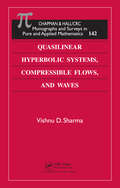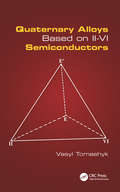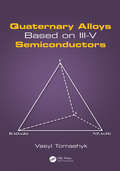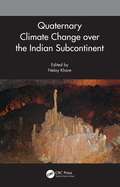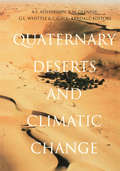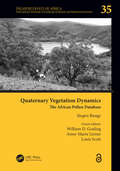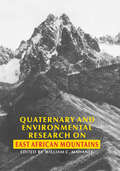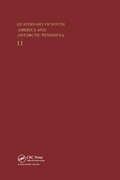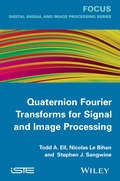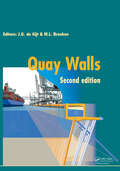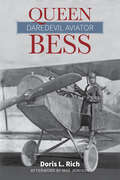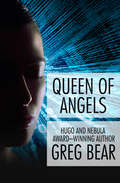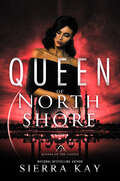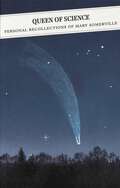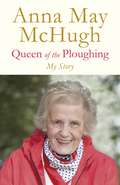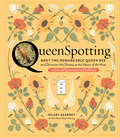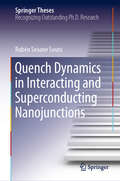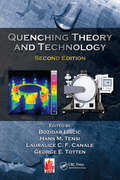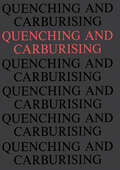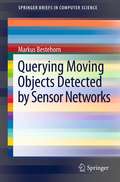- Table View
- List View
Quasilinear Hyperbolic Systems, Compressible Flows, and Waves
by Vishnu D. SharmaFilled with practical examples, Quasilinear Hyperbolic Systems, Compressible Flows, and Waves presents a self-contained discussion of quasilinear hyperbolic equations and systems with applications. It emphasizes nonlinear theory and introduces some of the most active research in the field.After linking continuum mechanics and quasilinear partial di
Quaternary Alloys Based on II - VI Semiconductors
by Vasyl TomashykDoped by isovalent or heterovalent foreign impurities, II-VI semiconductor compounds enable control of optical and electronic properties, making them ideal in detectors, solar cells, and other precise device applications. Quaternary alloys allow a simultaneous adjustment of band gap and lattice constant, increasing radiant efficiency at a wide rang
Quaternary Alloys Based on III-V Semiconductors
by Vasyl TomashykBoca Raton : CRC Press, 2017. | Includes index
Quaternary Climate Change over the Indian Subcontinent
by Neloy KhareQuaternary studies provide the essential context for evaluation of what is happening with the earth's climate today, and to clarify our vulnerability to hazardous natural processes. This book covers scientific aspects of past and present climatic changes of the quaternary period focused on the Indian subcontinent via response of modern environmental conditions on climate proxies, reconstruction of paleoclimate, paleomonsoon, glacial geology, climate variabilities using dendrochronology, cave deposits including quaternary tectonics and climate change over the Himalayan region. It consists of data generated from different landforms including lakes, caves, rivers, swamps, pits, and trenches using different proxies. Aimed at researchers, graduate students, professionals in geology, geography and environmental sciences, micropaleontology, and Quaternary climate change, this book: Studies Quaternary climate using various proxies in varied environments on the Indian sub-continent Covers pertinent historical and environmental archives to understand the current climate scenario Discusses the impact of climate change on biotic and abiotic components Includes thorough review of paleoclimate change studies Devotes significant space to glacial geology and all glacial climate proxies
Quaternary Deserts and Climatic Change
by K. W. Glennie A. S. Alsharhan G. L. Whittle C.G. St.C. KENDALLThese proceedings record the results of climate change in many areas which are hyper-arid deserts today but which, almost cyclically, at intervals of thousands or even hundreds of thousands of years, have had a much more humid climate.
Quaternary Vegetation Dynamics: The African Pollen Database (Palaeoecology of Africa #35)
by Jürgen RungeThis book celebrates the relaunch of the African Pollen Database, presents state-of-the-art of modern and ancient pollen data from sub-Saharan Africa, and promotes Open Access science. Pollen grains are powerful tools for the study of past vegetation dynamics because they preserve well within sedimentary deposits and have a huge diversity in ornamentation that allows different taxa to be determined. The reconstruction of past vegetation from the examination of ancient pollen records thus can be used to characterize the nature of past landscapes (e.g. abundance of forests vs. grasslands), provide insights into changes in biodiversity, and gain empirical evidence of vegetation response to climatic change and human activity. In this, the 35th Volume of "Palaeoecology of Africa", we bring together new data and extensive synthetic reviews to provide novel insights into the relationships between human evolution, human activity, climate change and vegetation dynamics during the Quaternary, the last 2.6 million years. Current and ongoing climate and land-use change is exerting pressure on modern vegetation formations and threatening the livelihoods and wellbeing of many peoples in Africa. In this book the focus is on the Quaternary because it is during this geological period that the modern vegetation formations developed into their current configurations against a backdrop of high magnitude global climate change (glacial-interglacial cycles), human evolution, and a growing human land-use footprint. In this book the latest information is presented and collated from around the African continent to parameterize past vegetation states, identify the drivers of vegetation change, and assess the vegetation resilience to change. To achieve this research from two broad themes are covered: (i) the present is the key to the past (i.e. studies which improve our understanding of modern environments so that we can better interpret evidence from the past), and (ii) the past is the key to the future (i.e. studies which unlock information on how and why vegetation changed in the past so one can better anticipate trajectories of future change). This Open Access book will provide a strong foundation for future research exploring past ecological, environmental and climatic change within Africa and the surrounding islands. The book is organized regionally (covering western, eastern, central, and southern Africa) and it contains specialized articles focused on particular topics (such as modern pollen-vegetation relationships and fire as a driver of vegetation change), as well as regional and pan-African syntheses drawing together decades of research to assess key scientific questions (including the role of climate in driving vegetation change and the role of vegetation change in human evolution). These articles will be useful to students and teachers from high school to the highest level of university who are interested in the origins and dynamics of vegetation in Africa. Furthermore, it is also meant to provide societally relevant information that can act as an inspiration for the development of sustainable management practices for the future.
Quaternary and Environmental Research on East African Mountains
by William C. MahaneyTwenty-six papers form a summary of research on glacial history, paleoclimatology, biogeography, ecosystem disequilibrium. Focus is on detailed chrono-stratigraphic, glacial geologic, and vertebrate paleontologic problems.
Quaternary of South America and Antarctic Peninsula
by Jorge RabassaThis volume is a compilation of papers of the final meeting of the IGCP Project 201, Quaternary of South America. The papers deal with a range of topics from quaternary vertebrate palaeontology in Argentina to biostratigraphy and chronological scale of uppermost Cenozoic in the Pampean area.
Quaternary of South America and Antarctic Peninsula
by Jorge RabassaThis volume contains a range of topics from quaternary vertebrate palaeontology in Argentina and biostratigraphy of uppermost Cenozoic in the Pampas. It determines the ice-rafted lithoclasts by the observation on thin slides, the latter issued from the rock sustratum of the Antarctic continent.
Quaternary of South America and Antarctic Peninsula
by Jorge RabassaThis volume is a compilation of papers that deal with palaeoecological aspects of Argentina and Uruguay, and that derive from the special session on the Quaternary of South America at the XIIth INQUA International Congress held in Ottawa in 1987.
Quaternary of South America and Antarctic Peninsula
by Jorge RabassaThis book focuses on the problems of the Quaternary in South America and Antarctic Peninsula, with a strong emphasis in the paleoenvironmental and paleoclimatic approach. It is based on contributions presented at the South American Regional Meeting held in Neuquen, Argentina.
Quaternary of South America and Antarctic Peninsula 1983
by Jorge RabassaThis book focuses on the problems of the Quaternary in South America and Antarctic Peninsula, with a strong emphasis in the paleoenvironmental and paleoclimatic approach. It is based on contributions presented at the South American Regional Meeting held in Neuquen, Argentina.
Quaternary of South America and Antarctica Peninsula 1998
by JORGE RABASSA; MÓNICA SALEMMEThis text deals with certain geological aspects of the extreme geographical locations of South America and the Antarctic Peninsula. Topics include: Brazil - geology and vertebrate paleontology; pleistocene wave-built terraces of Northern Rio de Janeiro state; and holocene coastal evolution.
Quaternion Fourier Transforms for Signal and Image Processing
by Stephen J. Sangwine Todd A. Ell Nicolas Le BihanBased on updates to signal and image processing technology made in the last two decades, this text examines the most recent research results pertaining to Quaternion Fourier Transforms. QFT is a central component of processing color images and complex valued signals. The book’s attention to mathematical concepts, imaging applications, and Matlab compatibility render it an irreplaceable resource for students, scientists, researchers, and engineers.
Quay Walls
by J.G. de Gijt M. L. BroekenThis new edition of the handbook of Quay Walls provides the reader with essential knowledge for the planning, design, execution and maintenance of quay walls, plus general information about historic developments and lessons gained from observation of ports in various countries. Technical chapters are followed by a detailed calculation of a quay wall, based on semi-probabilistic design procedures, applying the theory presented earlier. New experience has been obtained by many practitioners using the book, as well as the new Eurocodes in 2012 and additional recommendations for using FEM-analysis with quay wall design, leading to the need to update this handbook.
Queen Bess
by Doris L. RichHere is the brief but intense life of Bessie Coleman, America's first African American woman aviator. Born in 1892 in Atlanta, Texas, she became known as "Queen Bess," a barnstormer and flying-circus performer who defied the strictures of race, sex, and society in pursuit of a dream.
Queen of Angels (Questar Ser.)
by Greg BearHugo Award Finalist: A near-future novel of artificial intelligence, human nature, and mass murder that &“succeeds on virtually every level&” (The New York Times Book Review). In Los Angeles in 2047, advances in the science of psychology have made crime a rare occurrence. So it&’s utterly shocking when eight bodies are detected in an apartment, and not long afterward the perpetrator is revealed as well: noted poet Emmanuel Goldsmith. The LAPD&’s Mary Choy—who has had both her appearance and her police work enhanced by nanotechnology—is tasked with arresting the killer, while psychotherapy pioneer Martin Burke prepares to explore his mind. Meanwhile, Goldsmith&’s good friend and fellow writer reels at the news—while, far from all of them, a space probe makes a startling discovery. This &“excellent&” novel about technology, identity, and the nature of consciousness is a thought-provoking stunner by the Nebula Award–winning author of the Eon series and the Forerunner Saga (Chicago Tribune).
Queen of North Shore (Queens of the Castle #3)
by Sierra KaySolange Porter never believed her husband, Emmitt would betray her. But he did. First, he died when he promised they'd be together forever. Then, he left her as the head of a tech company that she didn’t want to lead. She wasn’t alone; most of the staff felt the same way.Computer programmer Wale Adisa needs Solange’s help. To get it, he will share a secret that Emmitt never revealed to her. This secret will not only increase her feelings of betrayal. It may also place a target on her back that could ruin her and the company she’s trying to save.ABOUT THE QUEENS OF THE CASTLE SERIESEach Queen book is a standalone, NO cliffhangersUSA TODAY, and National Bestselling Authors have created a world where women can—and will have it all—love, family, career, and leave a legacy while overcoming generational challenges.These powerful women, brought together for a higher purpose, change lives by providing safety for those who cannot protect themselves; care for those from tragic backgrounds, and make an impact on their families, communities, and the world at large. The Kings laid the foundation; the Knights created a bridge of hope between continents; but the Queens will change the world.Book 1–Queen of LahianaBook 2–Queen of Shadow BayBook 3–Queen of North ShoreBook 4–Queen of BelizeBook 5–Queen of KingstonBook 6–Queen of CambridgeBook 7–Queen of WilmetteBook 8—Queen of CuraçaoBook 9– Queen of Bahia
Queen of Science: Personal Recollections of Mary Somerville (Canongate Classics #102)
by Mary SomervilleThe complete memoirs of the 19th century scientist, public intellectual, and first female member of the Royal Astronomical Society.Born in Jedburgh in 1780, Mary Fairfax was the daughter of a captain in Lord Nelson&’s navy. In common with most girls of her time and station, she received an education that prized gentility over ability. Nevertheless, she taught herself algebra in secret, and made her reputation in celestial mechanics with her 1831 translation of Laplace&’s Mécanique céleste as The Mechanism of the Heavens.A brilliant polymath with interests in art, literature and nature, Somerville&’s memoirs give a fascinating picture of her life and times from childhood in Burntisland to international recognition and retirement in Naples. She recounts memories of comets and eclipses, high society in London and Paris, Charles Babbage and his calculating engine, encounters with Sir Walter Scott and Fenimore Cooper, the Risorgimento in Italy and the eruption of Vesuvius.Selected by her daughter and first published in 1973, these are the memoirs of a remarkable woman who became one of the nineteenth century&’s most accomplished mathematicians and scientists. Oxford&’s Somerville College was named after her, and the present volume, re-edited by Dorothy McMillan, draws on manuscripts owned by the college, offering the first unexpurgated edition of these revelatory writings.
Queen of the Ploughing
by Anna May McHugh'The embodiment of the spirit of rural Ireland'Anna May McHugh's name is synonymous with 'the Ploughing' - the annual Championships of the National Ploughing Association. The event is the biggest outdoor agricultural show in Europe and Anna May is the driving force behind its spectacular growth.Anna May now tells her story. Her description of growing up as part of a large family in rural County Laois is an evocative and affectionate account of an Ireland that is now gone. But in her account of how she went from being a secretary of the Ploughing Association, her first job, to becoming - to her own amazement - its managing director twenty years later is a story of leadership and people skills that are very much of the twenty-first century. Anna May was truly ahead of her time.Still living in County Laois, close to where she grew up, and now in her eighties, Anna May still runs the multi-million euro operation from her home, alongside her daughter, Anna Marie. Queen of the Ploughing is a captivating read, full of warmth, lively stories and Anna May's sharp observations. And it's not just about Anna May's life, but is also a celebration of the best of Irish life over eight decades.
QueenSpotting: Meet the Remarkable Queen Bee and Discover the Drama at the Heart of the Hive; Includes 48 Queenspotting Challenges
by Hilary KearneyAt the heart of every bee hive is a queen bee. Since her well-being is linked to the well-being of the entire colony, the ability to find her among the residents of the hive is an essential beekeeping skill. In QueenSpotting, experienced beekeeper and professional “swarm catcher” Hilary Kearney challenges readers to “spot the queen” with 48 fold-out visual puzzles — vivid up-close photos of the queen hidden among her many subjects.QueenSpotting celebrates the unique, fascinating life of the queen bee chronicles of royal hive happenings such as The Virgin Death Match, The Nuptual Flight — when the queen mates with a cloud of male drones high in the air — and the dramatic Exodus of the Swarm from the hive. Readers will thrill at Kearney’s adventures in capturing these swarms from the strange places they settle, including a Jet Ski, a couch, a speed boat, and an owl’s nesting box. Fascinating, fun, and instructive, backyard beekeepers and nature lovers alike will find reason to return to the pages again and again. This publication conforms to the EPUB Accessibility specification at WCAG 2.0 Level AA.
Quench Dynamics in Interacting and Superconducting Nanojunctions (Springer Theses)
by Rubén Seoane SoutoEffects of many-body interactions and superconducting correlations have become central questions in the quantum transport community. While most previous works investigating current fluctuations in nanodevices have been restricted to the stationary regime, Seoane's thesis extends these studies to the time domain. It provides relevant information about the time onset of electronic correlations mediated by interactions and superconductivity. This knowledge is essential for the development of fast electronic devices, as well as novel applications requiring fast manipulations, such as quantum information processing. In addition, the thesis establishes contact with issues of broad current interest such as non-equilibrium quantum phase transitions.
Quenching Theory and Technology
by George E. Totten Hans M. Tensi Božidar Liščić Lauralice C. F. CanaleQuenching is one of the most fundamentally complex processes in the heat treatment of metals, and it is something on which mechanical properties and distortion of engineering components depend. With chapters written by the most respected international experts in the field, Quenching Theory and Technology, Second Edition presents the most authoritat
Quenching and Carburising: Proceedings of the 3rd International Seminar of the International Federation for Heat Treatment (Melbourne, 1991)
by Peter D. HodgsonProceedings of the 3rd International Seminar of the International Federation for Heat Treatment held in Melbourne, in 1991 with the special focus on ‘Quenching and Carburising’. Quenching and Carburising are two of the most basic and widely practised steel heat treatment processes. Each allows the base properties and performance of the steel to be significantly enhanced, such that a relatively inexpensive and simple starting material can be used for a wide range of demanding applications. Nevertheless, the technological developments within those two processes are often ignored in favour of ‘high tech’ surface treatments. The aim of Quenching and Carburising was to review the recent advancements that have been made in these fields.
Querying Moving Objects Detected by Sensor Networks
by Markus BestehornDeclarative query interfaces to Sensor Networks (SN) have become a commodity. These interfaces allow access to SN deployed for collecting data using relational queries. However, SN are not confined to data collection, but may track object movement, e.g., wildlife observation or traffic monitoring. While rational approaches are well suited for data collection, research on Moving Object Databases (MOD) has shown that relational operators are unsuitable to express information needs on object movement, i.e., spatio-temporal queries. Querying Moving Objects Detected by Sensor Networks studies declarative access to SN that track moving objects. The properties of SN present a straightforward application of MOD, e.g., node failures, limited detection ranges and accuracy which vary over time etc. Furthermore, point sets used to model MOD-entities like regions assume the availability of very accurate knowledge regarding the spatial extend of these entities, assuming such knowledge is unrealistic for most SN. This book is the first that defines a complete set of spatio-temporal operators for SN while taking into account their properties. Based on these operators, we systematically investigate how to derive query results from object detections by SN. Finally, process spatio-temporal queries are shown in SN efficiently, i.e., reducing the communication between nodes. The evaluation shows that the measures reduce communication by 45%-89%.
